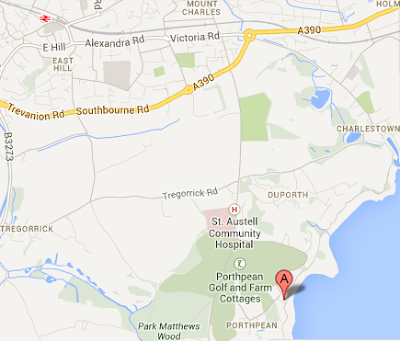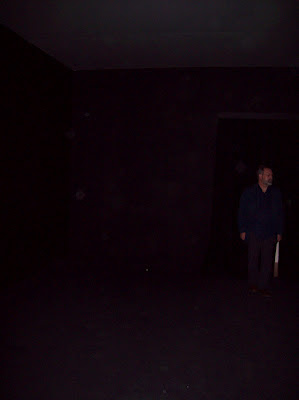We strolled a few yards up the damp road and into the pub. The board outside was there, advertising the competition for 8.30, but there was hardly anybody in. The gambling machine's display seemed to be keeping time with the piped music, until a man returned to it and fed in a tenner, which took several goes.
"It's full."
"I know, I'm trying to get some of it back out."
Gradually the entrants gathered: three chefs on our left, a couple of solitaries at this end of the bar, and a trio of regulars at the other end, hidden behind the pillar.
"We'll start at nine."
A man and his girlfriend dropped in to tell the owner about the funeral arrangements for a local who'd be known to others here, though he'd kept himself to himself.
Then we began. Welcome to the fourth pub quiz at the Castle. Googlers would be instantly disqualified. Prize a ten pound bar tab for the winner, and a packet of crisps for the best team name. As Brummies, my wife said we should be the Peaky Blinders.
"Is there a picture round?"
We said it would be whoever could draw the best picture, but the barman handed us all a streakily-copied sheet of logos to identify.
A couple of years ago at the Waterman's, a big bloke had come in dressed as a Roman soldier and been thrown out for farting. The question-setter that time had been Lily, who'd escaped the dullness of Plymouth, but she's moved on again with baby and partner. Her sheets were full-colour and artistically illustrated.
Our host began squinting at his iphone and reading out questions.
"What type of monkey lives on the Rock of Gibraltar?"
"Orang-utans," said one of the chefs to his mates.
"Spaniards."
The lone wolves were comparing notes on the picture round.
"What element is needed for all forms of combustion?"
CO2 wasn't right when we came to mark a loner's sheet, but he can't have heard the barman remark "Another oxygen-related question" to the regulars round the corner.
Between rounds, the majority decamped to the pavement outside for a smoke, including Mine Host, leaving his taps vulnerable in the near-deserted bar. Stupid law.
A chef showed us a party picture on his phone, with two ghosts' heads in the group. Later, one of his mates suggested it could be done by someone changing position while the phone panned round. Post-quiz, a couple of girls turned up, one of whom had taken the pic, and she said they hadn't done that.
Next round. One of the loners left abruptly. He'd scored 5 out of 20, most questions not answered and the rest semi-legible. His response to "What do the letters RAM stand for in computing?" had been "ramofocation". (What do the letters THC stand for?)
Another chef came in and was updated on the ghosts.
"What are there twenty-six pairs of in the human body?"
We got an extra point for spelling chromosomes right. We had briefly considered "bollocks."
There was much anguish over what the C stood for in YMCA. And when asked what nuts were used in making pesto, the chefs agreed on cashews. Apparently the answer to "the butcher, the baker and the..." was not Old Mother Hubbard. The cry in fencing was what we'd put, "T
ouché!", not "Dun ya!" as they'd said - and there was no consolation point for correct punctuation.
Then there was the dispute with the quizmaster.
"What is the coloured part of the eve called?"
"Don't you mean eye?"
"No, there's no i in it."
"No, a y instead of a v."
"It definitely says eve," said the barman, screwing up his eyes and peering closer.
"If it's eye it's iris," said the remaining loner.
We settled for eye.
The Peaky Blinders struggled with the logos. Mercedes and Camel cigarettes were a cinch, but the double W defeated us (Wonder Woman) and the stylised R (Robin, Batman's partner). The head surrounded by a Greek wave motif turned out to be Versace.
The last question was impromptu, because of IT malfunction. "It's covered by the Google bar." "Move your thumb up." "I've done that."
So he thought and gave us, "What Spanish island did I spend a few months on when I was 21?"
"Alcatraz," said the loner.
"Majorca."
"No, it wasn't Majorca," said the barman.
We did our best.
The regulars beat us by two points, one of which I'd lost when I made my wife put yellow instead of white for the colour Wimbledon tennis balls used to be before they turned green. And we'd forgotten the candlestick in the six murder weapons in Cluedo; and it was a revolver, not a pistol (Mine Host had been very firm on that). The winners promptly left.
Best team name was between the chefs, who'd concocted something ending with a c followed by hunt, and the loner's Alone In The Dark. I gave my casting vote for the latter and the chefs accepted the justice of losing out for obscenity.
I stayed on for a half pint of lager while my wife went back to make a cheese and onion sandwich for me, but without onion as we'd used it up. The loner was a graphic designer who told me all sorts of interesting things about design, photography, maintaining copyright on the internet and making websites. He reckoned his 8-year-old child was ahead of him and you didn't need to be in London to go global any more.
A Hendrix documentary was on the screen behind us. I recalled seeing the news of his death as I walked into Newport bus station; AITD told me he'd covered it at college. Memory versus history. I told him what I'd only recently learned about how Bruce Lee had died (aspirin, the studio had spun -rubbish, it was Nepalese hash, especially dangerous if you had no body fat to absorb the toxins); he told me about his own martial arts expertise.
Home for a cheese sandwich, a shot of Chivas and the rest of Hendrix.
All original material is copyright of its author. Fair use permitted. Contact via comment. Unless indicated otherwise, all internet links accessed at time of writing. Nothing here should be taken as personal advice, financial or otherwise. No liability is accepted for third-party content, whether incorporated in or linked to this blog; or for unintentional error and inaccuracy. The blog author may have, or intend to change, a personal position in any stock or other kind of investment mentioned.
















